Abstract
In response to the ongoing depletion of fishery resources, many countries now prioritize sustainable fish stock use and ecosystem protection, balancing ecological, economic, and social goals. Fishery subsidies are key in this shift, with their impact depending on design and implementation. In 2020, China introduced marine fishery resource conservation subsidies and simultaneously phased out a 15-year policy of harmful fuel subsidies. This study uses evolutionary game theory to analyze the strategic interactions between government authorities and fishermen across four institutional scenarios, each combining different forms of subsidies and penalties. The findings suggest that a dynamic approach, incorporating both subsidies and penalties, is most effective in promoting legal fishing practices and protecting marine resources. Additionally, the study emphasizes that the effectiveness of subsidies and penalties does not necessarily increase with their scale; instead, both must be carefully calibrated to sustainable and reasonable limits.
Keywords:
fishery resource conservation subsidy; the government; fishers; penalty; evolutionary game theory Key Contribution:
This manuscript innovatively integrates evolutionary game theory with national empirical data to examine how subsidy and penalty mechanisms influence fisher behavior and promote sustainable fishery management under China’s new fishery resource conservation subsidy system.
1. Introduction
As a fundamental component of the blue economy, marine fisheries function as a primary driver of economic growth and development in coastal regions. They provide a primary source of food security, employment, and income and contribute significantly to the preservation of cultural heritage and social stability within coastal communities. The sustainable development of marine fisheries is thus intricately linked to human well-being, ecological balance, and broader economic advancement. According to the Food and Agriculture Organization [1], the global marine capture sector produced 79.7 million metric tons of aquatic animals and supported approximately 15.5 million jobs in 2022. However, in recent years, global marine fishery yields exhibited a downward trend, with a 0.7% decline from 2021 and a 5.5% decrease compared to the peak in 2018. Alarmingly, several commercially significant species, such as sardines, experienced severe overexploitation. According to the General Fisheries Commission for the Mediterranean [2], sardine stocks in the western Mediterranean have been overfished since the early 2000s, with current biomass levels far below sustainability thresholds. The proportion of fish stocks classified as overfished increased from 35.4% in 2019 to 37.7% in 2021 [1], underscoring the urgent need for more effective and sustainable fishery management practices.
Multiple factors contribute to the persistent challenge of overfishing, including inadequate management of fisheries, elevated consumer demand, and the proliferation of advanced fishing technologies. Among these, the role of government subsidies in fostering excess fishing capacity is particularly significant and cannot be ignored. For example, Clack et al. [3] demonstrate that capacity-enhancing subsidies—such as fuel tax exemptions and vessel construction support—distort market incentives, leading to increased fishing effort and long-term depletion of fish stocks. Although subsidies are typically implemented with commendable objectives—such as promoting industrial growth, enhancing employment opportunities, or addressing social and distributive equity—they often alter fishing operations’ economic dynamics by increasing revenues or reducing operational costs [4]. For example, fuel subsidies reduce the cost of fishing trips, allowing vessels to operate longer or more frequently, which can lead to excessive fishing efforts and exacerbate overexploitation. Consequently, many subsidies function as perverse incentives, encouraging excessive investment in fishing capacity and infrastructure. Given limited management capacity and open-access regimes—such as inadequate monitoring and enforcement, absence of effective catch limits, and unrestricted entry into the fishery—intensified competition among fishers frequently results in overexploitation, driving resource rents toward zero and leading to declines in both fish stocks and total catch [4]. Sumaila et al. [5] report that capacity-enhancing subsidies constituted USD 22.2 billion of the USD 35.4 billion in global fishery subsidies in 2018. Nearly two-thirds of global commercial fish stocks are fully exploited or overexploited, with subsidies identified as a significant driving force behind this trend [6].
As the largest contributor to the catch of global marine fisheries, China has come under significant pressure to address the degradation of its marine ecosystems. Approximately 40 of China’s 52 offshore fishing grounds experienced significant resource depletion, accompanied by the disappearance of traditional fishing seasons [7]. With escalating fishing intensity and effort, China’s fishery resources continued to decline, and fish stocks increasingly exhibit traits such as younger age structures and lower biological quality [8]. In recent decades, approximately 80% of the catch within China’s Exclusive Economic Zone (EEZ) (Figure 1) consisted of low-value, small pelagic species [9]. In the South China Sea, low-value and juvenile fish account for over 70% of total landings [10]. The modest decline in marine fishing output in recent years has been attributed to the phenomenon of “fishing down”—targeting smaller, lower-trophic-level species—as well as demand-driven and subsidy-fueled offshore expansion [10].
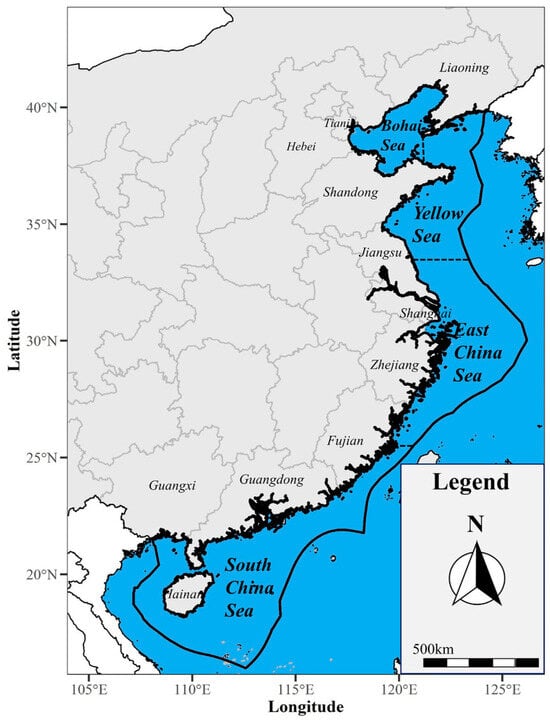
Figure 1.
Map of mainland China’s Exclusive Economic Zone (EEZ).
To promote sustainable marine fisheries and curb resource overexploitation, the Chinese government reformed its subsidy system by replacing fuel subsidies with fishery resource conservation subsidies in 2021. These performance-based subsidies incentivize environmentally responsible behavior among fishers by linking payments to specific conservation activities, such as compliance with seasonal moratoriums and adherence to responsible fishing regulations.
Although the reform is designed to achieve long-term ecological benefits by mitigating overfishing and resource depletion, it may have immediate negative effects on fishers’ incomes. On the one hand, a fishing moratorium reduces working hours; on the other, regulations prohibit the harvest of juvenile fish and species protected under national legislation. Scholars observed that efforts to reduce poverty and promote economic growth in many developing countries often conflict with environmental preservation [11]. Given that approximately 12 million people are employed in China’s fishery sector, balancing ecological sustainability with the livelihoods of coastal communities presents a critical policy challenge. The successful implementation of conservation subsidies depends not only on government enforcement but also on the active participation of fishers. Recognizing the oceans’ vital role in global social–ecological systems, this study develops a dynamic evolutionary game model involving both the government and fishers. The model examines the strategic responses of both parties under various penalty mechanisms, aiming to encourage fishers to comply with regulations and ultimately achieve a win–win outcome of sustainable fisheries and long-term income growth.
2. China’s Fishery Subsidy Reforms and Game Theory
2.1. China’s Fishery Subsidy Reform
Over the past few decades, China’s fishery subsidy policy has undergone substantial transformation, driven by shifts in national policy priorities, the fishery sector’s strategic development, and changing marine resource conditions, reflecting an increasing emphasis on sustainable resource management.
Since the 1980s, the Chinese government has implemented a series of subsidies to support the development of the fishing industry, focusing on vessel construction, fuel assistance, and capacity expansion to enhance seafood production and modernize the fishing fleet. In 1985, China began encouraging the development of distant-water fisheries (DWF) through the implementation of preferential policies, promoting the participation of eligible vessels in distant-water fishing operations. In the following year, the Fisheries Law (1986) was enacted, providing financial, material, technical, and tax support for offshore and pelagic fishing. Subsequently, the coverage and variety of fishery subsidies continued to expand. In 2002, the Ministry of Agriculture (MOA) introduced the “dual-transition” subsidy policy, which aimed to reduce the number of fishing vessels and control fishing intensity by encouraging fishers to exit capture fisheries and transition into aquaculture or fish processing industries.
In 2006, the Chinese government introduced a fuel subsidy program to mitigate the impact of the rising fuel price. Driven by increasing concerns over marine ecosystem degradation, the MOA reformed its fuel subsidy program by decoupling the subsidy from actual fuel consumption in 2015. The fuel subsidy coefficient was supplanted by a comprehensive adjustment coefficient (CAC) to capture the ecological impacts of various pieces of fishing gear. The fuel subsidy standard was adjusted to the 2014 level and has been reduced by 18% annually till 2019 [12]. Although fuel subsidies lower operational costs and temporarily increase fishers’ income, they inadvertently encourage the expansion of vessel capacity and fishing intensity, exacerbating overfishing and accelerating resource depletion [13]. Over time, the policy deviated from its original intent, intensifying the decline of fish stocks, deepening socioeconomic inequalities, and heightening social tensions [14].
In 2021, China implemented a marine fisheries resources conservation subsidy to protect fishery resources and promote the sustainable development of its marine fishing sector. This policy marked a significant shift, replacing the fuel subsidies in place for 15 years. To encourage fishers to protect fishery resources, the marine fishery resources conservation subsidy program establishes more explicit criteria and subsidy reduction rules compared to the fuel subsidy scheme, thereby guiding fishing vessels to fulfill conservation tasks to qualify for the full subsidy. The provision of subsidies is primarily based on two conditions: compliance with seasonal fishing moratoriums and the implementation of responsible fishing practices. Each part accounts for 50% in principle: annual marine resources conservation subsidy = moratorium (50%) + responsible fishing (50%). The fishing moratorium refers to the seasonal ban on marine fishing, intended to reduce fishing intensity and allow fish stocks to recover. Responsible fishing ensures that it is conducive to the conservation of marine resources. The resource conservation subsidy adopts “post-subsidize” mode: only those vessels that strictly obey the fishing moratorium and responsible fishing rules can be subsidized at the end of the subsidy year. Fishers who violate the fishing moratorium regulation may face a reduction or complete forfeiture of the fishing moratorium subsidy, depending on the frequency of their violations. As the responsible subsidy contains different indicators and coefficients, the local government can make adjustments. Port entry and exit reporting, position monitoring, fishing logbooks, designated port landings, and marine mammal protection are mandatory indicators, while quota-based fishing, gear management, juvenile fish ratio, and legal labeling are optional indicators—each reflecting the effectiveness of regulatory compliance and resource conservation. Non-compliance with responsible fishing regulations will result in a deduction from the subsidy, based on the coefficient. Additionally, vessels that violate regulations incur both subsidy reductions and financial penalties. With the implementation of the resource conservation subsidy, China’s nearshore resource conservation exhibited initial signs of recovery. Scientific monitoring demonstrated that, despite minor annual fluctuations, the overall abundance of China’s nearshore fishery resources stabilized, with several species exhibiting sustained improvements. Nevertheless, the fundamental trend of resource depletion remains unaltered. Consequently, further research is necessary to inform future fishery subsidy reforms aimed at reducing excess fishing capacity, mitigating ecological and biodiversity impacts.
2.2. Game Theory in Fisheries
Governments and fishers are seldom fully informed or entirely rational in their decision-making regarding fisheries. Instead, they tend to observe and influence each other before formulating their strategic choices. Current research on the application of game theory to marine fisheries can be broadly classified into two categories.
The first category focuses on the application of classical game theory to fisheries, primarily examining the behavior of fishing nations, communities, or individual fishers under static equilibrium conditions and its implications for the sustainable management of fish stocks. Sumaila [15] utilizes game theory to analyze strategic interactions among fishers operating under various management regimes, demonstrating how these dynamics can often result in suboptimal outcomes for both resource sustainability and economic efficiency. Hannesson [16] explores the strategic behavior of multiple players—particularly nations and communities sharing fishery resources—highlighting how short-term economic incentives frequently drive overfishing, while long-term sustainability is often neglected. Grønbæk et al. [17] apply game theory to analyze the strategic interactions among nations exploiting shared marine resources, highlighting that, without effective cooperation, these dynamics frequently result in overfishing.
The second category centers on the application of evolutionary game theory, which has become an increasingly valuable tool in addressing complex challenges in marine fisheries. Ding et al. [7] employ evolutionary game theory and find that while stringent penalties effectively deter non-compliant behavior, subsidies must be applied moderately during the implementation of seasonal marine fishing moratoriums. Zheng and Yu [18] construct a tripartite evolutionary game to reveal that the probability of subsidies positively influences the behaviors of both fishers and consumers. Chen and Hu [19] analyze manufacturers’ behavioral responses under different combinations of carbon taxes and subsidies, concluding that a bilateral dynamic mechanism is more effective, with carbon taxes having a greater impact than subsidies alone.
In recent decades, attention to the sustainability of fisheries has grown rapidly, leading to extensive research on fishery subsidies and marine conservation. However, few in-depth studies explored fishery subsidies through the lens of evolutionary game theory, particularly concerning the strategic behaviors of fishers and governments under the new marine resource conservation subsidy policy.
This study employs game theory to analyze the strategic interactions between the government and fishers in the implementation of fishery resource conservation subsidies. It aims to identify pathways for optimizing incentive and punitive mechanisms to enhance the effectiveness of future policy implementation and develop a comprehensive fishery management framework. Such efforts are essential to ensure that the actual outcomes of subsidy programs align with their intended objectives and support the long-term sustainability of the fisheries sector. The research focuses on the following key questions:
- What are the strategic objectives of the government and fishers, and what conflicts arise between them?
- How can evolutionary game theory be applied to model and analyze the dynamic behaviors and strategy evolution of participants?
- What incentives and punitive mechanisms can promote fishers’ compliance with the resource conservation subsidy system and improve the sustainability of marine resources?
The remainder of this article is organized as follows: Section 3 constructs and solves the evolutionary game model. Section 4 presents results and analysis through numerical simulation. Section 5 presents the discussion of the study. Concluding remarks and some policy implications follow in the last section.
3. Evolutionary Game Analysis of Marine Resources Conservation Subsidy
This article develops an evolutionary game model for fishery resource conservation subsidies, involving two players: the government and fishers. Each player’s strategy influences the other.
The government is responsible for supervising fishing activities and selects the most appropriate regulatory strategy by weighing the costs against the effectiveness of supervision. It is assumed that the government has two possible strategies: supervision or non-supervision. Under the supervision strategy, fishers are either granted subsidies or penalised based on their compliance with conservation subsidy measures. Conversely, under the non-supervision strategy, fishers operate without oversight, which may result in the overexploitation of marine resources and the deterioration of marine ecological systems while reducing immediate administrative costs.
Fishers are responsible for engaging in lawful fishing per the fishery resource conservation subsidy policy. Their decision is typically based on a rational assessment of the relative benefits of each strategy. They face two strategic options: compliance or non-compliance. Compliance enables fishers to receive the full subsidy as compensation for income lost during fishing moratoriums, while non-compliance results in forfeiture of the subsidy and the imposition of fines. Fishers weigh whether the potential gains from illegal fishing outweigh the combined losses from penalties and withheld subsidies. Their behavior directly impacts the marine ecological environment and the recovery of fishery resources, which, in turn, affect long-term fishing incomes. Fishers’ behavior directly influences the marine ecological environment and the health of fish stocks, both of which affect long-term fishing incomes. Regardless of the government’s strategy, compliance by fishers consistently generates positive outcomes for all stakeholders—including fishers, the government, and the marine environment—whereas non-compliance incurs ecological or economic losses. Accordingly, ensuring fisher compliance constitutes the primary objective of the fishery resource conservation subsidy policy.
Assumptions and Parameters
Assumption 1.
The evolutionary game model involves two players: the government and fishers. Fishers choose between two strategic actions: compliance, non-compliance, while the government can choose either supervision or non-supervision of fishing activities. Let x represent the probability that fishers comply with fishery subsidy regulations, and y denote the probability that the government opts to supervise fishing behavior, where x, y ∈ [0, 1].
Assumption 2.

The government and fishers are boundedly rational with incomplete information; they would adjust their strategies over time to maximise profit. If fishers fully comply with fishery resource conservation regulations, they are entitled to receive a subsidy S from the government. In the absence of this subsidy, their income is denoted as I, and their cost of fishing as C1. Table 1 presents all the parameters.

Table 1.
Parameters and descriptions.
Assumption 3.
If fishers violate regulations by engaging in illegal fishing during the moratorium or by targeting protected marine species, they incur a higher cost, denoted as C2 (C1 < C2), and are ineligible to receive fishery subsidies. Additionally, they may be subject to a financial penalty, represented by F.
Assumption 4.
The government’s cost for supervising fishers’ activities is denoted by C. When fishers comply with regulations, the government gains substantial ecological and economic benefits, represented by E, due to improvements in the marine environment. Conversely, if fishers engage in illegal fishing, the government faces an ecological loss, denoted by L. The parameter d represents the proportion of additional revenue generated from illegal fishing.
The revenue matrix for both the government and fishers can be derived from the analysis above (Table 2). The Stability Analysis is shown in Appendix A (Appendix A.1).

Table 2.
The revenue matrix of fishers and the government.
4. Numerical Simulation
This section examines the strategic interactions between the government and fishers in implementing the fishery resource conservation subsidy policy based on an evolutionary game model and simulations conducted using MATLAB R2022b software.
The numerical simulation of the model is conducted based on the implementation of fishery resource conservation subsidies in China in 2022. According to the China Fishery Statistical Yearbook, the average annual income of fishers was CNY 24,600, while the average fishery subsidy amounted to approximately CNY 775 [20]. For the purpose of this simulation, it is assumed that the cost of government supervision is CNY 10,000, and the costs incurred by fishers for complying with and violating the regulations are CNY 30 and CNY 40, respectively. Fishers who violate the regulations are subject to a fine of CNY 4000, and the additional income anticipated from illegal fishing activities is estimated at 16%. Accordingly, the initial parameter values are set as follows: I = 250, S = 8, C = 10, C1 = 30, C2 = 40, F = 40, and d = 16%. The simulation is carried out based on these values.
4.1. Static Subsidy and Static Penalty
The equilibrium point analysis of the dynamical system (I) is presented in Appendix A.2. Based on the initial parameter values, the equilibrium point is calculated as (xD, yD) = (2/3, 5/8). Therefore, this point is used as the initial system strategy for simulation verification.
When the initial probability of fishers complying with regulations is set to x1 = 2/3, the evolutionary game trajectories of the government’s supervision strategy, with initial values y1 = 0.2, 0.4, 0.6, and 0.8, are illustrated in Figure 2. This indicates that when the initial probability of x corresponds to the equilibrium point and the initial value of y is fixed, the government’s supervision probability fluctuates over time, and the system fails to stabilize at the central equilibrium.
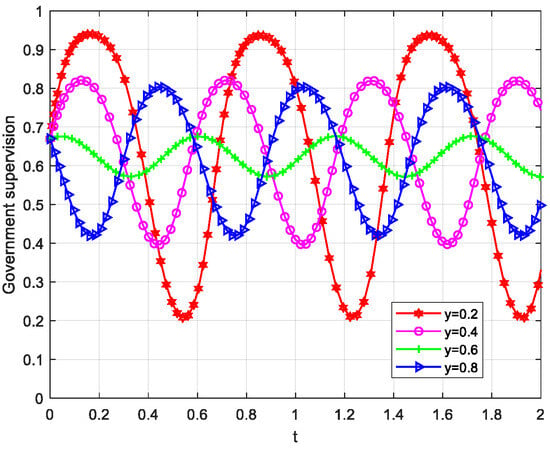
Figure 2.
When x1 = 2/3, evolution path of government regulation.
This means that when the initial probability of y is the equilibrium point and the initial value of x is fixed, the probability of government supervising fishers fluctuates, and the system does not stabilize at the central point.
When the initial probability of fishers complying with the regulations is y1 = 5/8, the evolutionary game trajectories for the government’s supervision strategy, given initial values of x1 = 0.2 and x1 = 0.8, are illustrated in Figure 3. These results suggest that when the initial value of y is set at the equilibrium point and x remains fixed, the probability of government supervision fluctuates over time, indicating that the system does not converge to a stable central equilibrium.
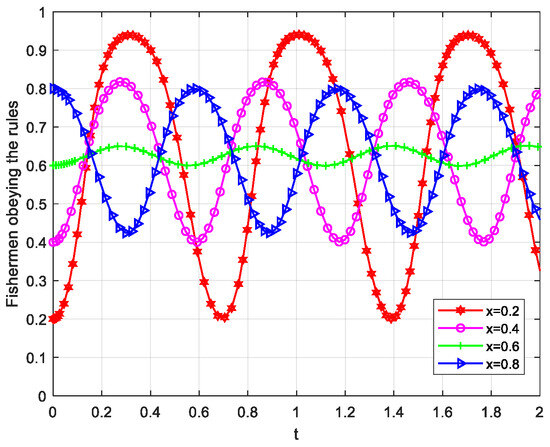
Figure 3.
When y1 = 5/8, the evolution path of fishers’ fishing activity.
When the system (I) is initialized with the same starting values, assuming (x1, y1) = (0.5, 0.5), the dynamic evolution is illustrated in Figure 4. The evolutionary trajectory forms a closed loop that oscillates periodically around the central point (xD, yD), without converging to a stable equilibrium. This suggests that both government supervision and fishers’ fishing behavior follow a cyclical pattern over time.
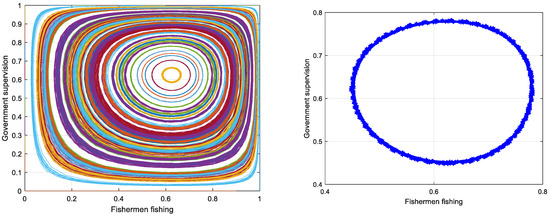
Figure 4.
The dynamic evolution of system (I). The first figure displays a series of trajectories in a two-dimensional phase space, showing different initial conditions or parameter combinations; while the second one is used to plot the trajectory.
4.2. Dynamic Subsidy and Static Punishment Mechanism
The fishery resource conservation subsidy consists of two components: the fishing moratorium subsidy and the responsible fishing subsidy, each accounting for half of the total amount. If fishers violate the rules of the subsidy program, their subsidies are reduced in proportion to the number of infractions. Consequently, the amount of subsidy received is directly linked to the legality of fishing practices. The government tends to allocate a larger share of subsidies when there is a high likelihood that fishers will comply with the regulations. Conversely, when the likelihood of compliance is low, fishers receive reduced or no subsidies.
The stability of the equilibrium points in system (II) is analyzed through local stability analysis using the Jacobian matrix (Appendix A.3). Numerical simulations are conducted using the same parameter values as in system (I). The evolutionary outcomes under the dynamic subsidy mechanism are presented in Figure 5. Compared to the static subsidy mechanism, the dynamic subsidy system exhibits substantially greater oscillation amplitudes, indicating greater difficulty in stabilizing the game dynamics. Figure 6 illustrates the evolutionary trajectory of system (II), which exhibits an outwardly expanding spiral originating from (xD′, yD′), reflecting the lack of a stable equilibrium point. This pattern suggests that the government and fishers’ strategic behaviours become progressively more volatile and uncertain over time.

Figure 5.
Evolution path of fishers’ and the government’s behaviors in system (I) and (II).
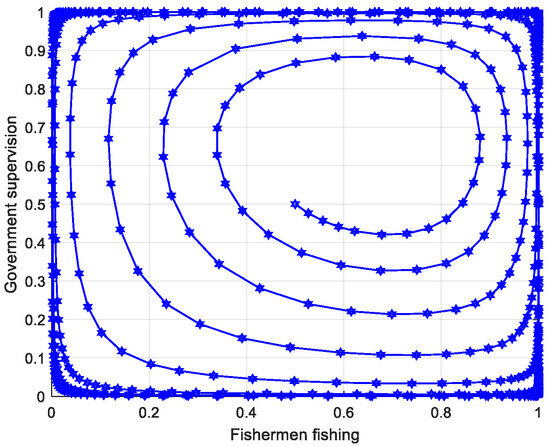
Figure 6.
The dynamic evolution of system (II).
4.3. Static Subsidy and Dynamic Punishment Mechanism
The stability analysis of the equilibrium points of system (III) is conducted using the local stability analysis method of the Jacobian matrix (Appendix A.4). Numerical simulations use the same parameter values as in system (I). The evolutionary outcomes under the static subsidy and dynamic penalty mechanism are presented in Figure 7. Under the static subsidy and static penalty framework, the probabilities of fishers complying with regulations (x) and the government supervising fishing activities (y) fluctuate within the range of [0.4, 0.8] over time, complicating the stabilization of the evolutionary game process. Under the dynamic subsidy and static penalty mechanism, the probabilities of legal fishing (x) and government supervision (y) steadily increase over time, indicating a further reduction in system stability. The dynamic evolutionary trajectory of system (III) is depicted in Figure 8. In contrast, under the static subsidy and dynamic penalty framework, x and y exhibit initial fluctuations but rapidly stabilize. Figure 8 demonstrates that the evolutionary interaction between the government and fishers converges to an asymptotically stable state. This suggests that the behaviors of both parties ultimately stabilize, with the probability of fishers complying with regulations approaching 1, while the probability of government supervision stabilizes around 0.4.
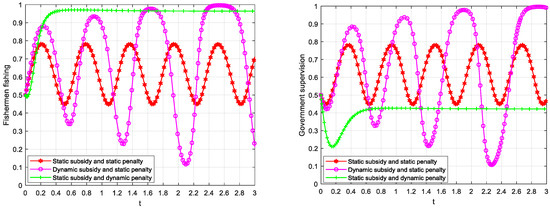
Figure 7.
Evolution path of fishers’ and the government’s behaviors in system (I–III).
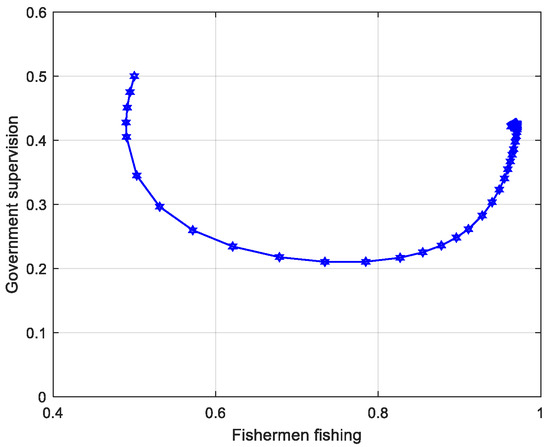
Figure 8.
The dynamic evolution of system (III).
4.4. Dynamic Subsidy and Dynamic Punishment Mechanism
The stability of the equilibrium points in system (IV) is analyzed using the Jacobian matrix local stability method (Appendix A.5). Figure 9 and Figure 10 illustrate the evolutionary outcomes under the dynamic subsidy and dynamic penalty scheme. The variables x and y exhibit similar evolutionary trajectories in system (IV) compared to system (III), with both systems stabilizing after brief fluctuations. However, a comparison between systems (III) and (IV) reveals that while both achieve stabilization after initial disturbances, the probability of fishers complying with fishing regulations is higher in system (IV), ultimately stabilizing at 1. Therefore, despite the lower probability of government supervision in system (IV), the dynamic subsidy and dynamic penalty mechanism is a relatively more effective strategy. The primary objective of the fishery resource conservation subsidy policies is to promote lawful fishing practices and curb IUU fishing.
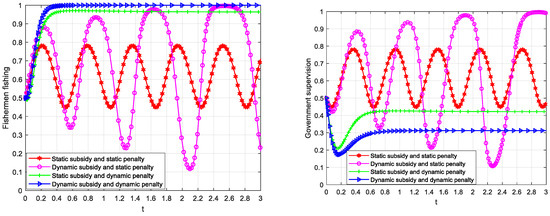
Figure 9.
Evolution path of fishers’ and the government’s behaviors in system (I–IV).
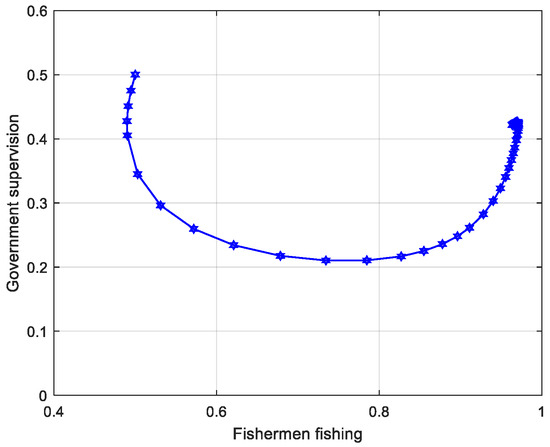
Figure 10.
The dynamic evolution of system (IV).
Analysis of the four dynamic evolutionary systems indicates that the system exhibits the most pronounced fluctuations under the dynamic subsidy and static penalty mechanism. By contrast, the dynamic subsidy and dynamic penalty mechanism achieves the highest compliance rates among fishers, making it the most desirable strategy for ensuring adherence to fishing regulations and promoting the sustainable use of marine resources.
4.5. Effects of Subsidy and Penalty Intensity on the Evolution Path of System (IV)
4.5.1. The Impact of Fishery Subsidy
The comparative analysis of the four systems indicates that system (IV), featuring a dynamic subsidy and dynamic penalty mechanism, is the most effective approach. Consequently, a sensitivity analysis of fishery subsidies and penalties is conducted under this mechanism.
The evolutionary trajectories of x and y respond differently to increases in the maximum fishery subsidy S, while all other parameters remain constant (Figure 11). Following a brief adjustment period, both x and y stabilize when the subsidy S is relatively low. When the fishery subsidy S decreases slightly during this stage, y adjusts and stabilizes around 0.3, while x remains close to 1. However, when the subsidy amount becomes substantial, both x and y exhibit instability and continuous fluctuations. As the subsidy S increases, x gradually declines during this period, while y shows a slight upward trend. These findings suggest that moderate fishery subsidies are beneficial in the early stages, as they help encourage legal fishing practices and contribute to marine ecological protection. However, in the long run, high subsidies may reduce the probability of fishers complying with conservation subsidy regulations and lead to behavioral volatility.
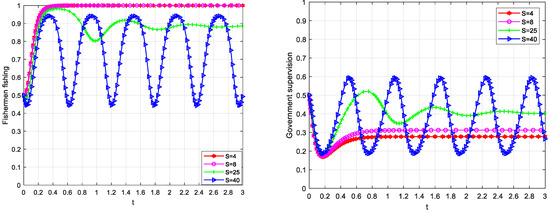
Figure 11.
Effect of subsidy intensity on government and fishers.
A plausible explanation is that excessive subsidies impose significant fiscal pressures on the government, thereby increasing the marginal cost of regulatory enforcement and potentially diminishing its willingness to maintain high levels of supervision. Concurrently, high subsidy levels may raise the government’s expectation of enforcement returns, indirectly prompting a potential increase in supervisory efforts. However, such increases also impose greater financial burdens on the government, elevating the cost of enforcement. Thus, the government may become hesitant to invest further in supervision, leading to inconsistency in regulatory actions. Empirical studies support this viewpoint. Yang et al. [21] found that excessive subsidies reduced the likelihood of food companies producing safe products, thereby diminishing policy effectiveness. Zhang [22], in a study of grassland ecological subsidies across 13 provinces, concluded that weak supervision and inequitable distribution limited the effectiveness of such subsidies in preserving grassland ecosystems.
4.5.2. The Impact of Government Penalty
When other parameters remain constant, the evolutionary trajectories of x and y respond differently to an increase in the maximum penalty F imposed by the local government, as illustrated in Figure 12. Higher penalties appear to enhance governmental motivation for enforcement, thereby increasing the likelihood of supervision. From the fishers’ perspective, it presents a significantly different pattern. At relatively low levels of F, the variable x—representing the probability of fishers engaging in legal fishing—stabilizes near 1 after a brief adjustment, suggesting that moderate fines effectively incentivize compliance. A moderate increase in fines under these conditions leads to rapid and stable compliance. However, the likelihood of legal fishing decreases when the fine becomes excessively high. This counterintuitive outcome may be due to fishers perceiving the fines as excessively harsh and beyond their tolerance, thereby triggering psychological resistance and increasing opportunistic behavior. Previous studies suggest that increasing the intensity of subsidies and penalties does not always translate into behavioral change [23]. Feng and Wang [24] similarly argue that high-intensity penalties offer no clear advantage over their lower-intensity counterparts. Zhang et al. [25] emphasize that effective incentive mechanisms require the dynamic adjustment of reward and penalty intensities, along with the careful determination of their upper thresholds.
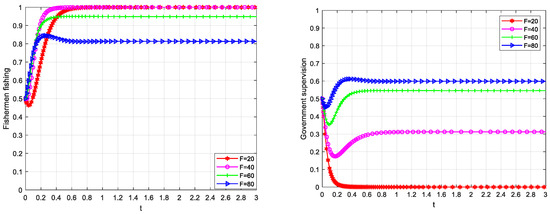
Figure 12.
Effect of penalty intensity on government and fishers.
5. Discussion
This study develops a dynamic evolutionary game model between fishers and the government to investigate the effectiveness of a resource conservation subsidy in promoting legal fishing practices and safeguarding marine resources. Using MATLAB for numerical simulations, it analyzes the evolution process and equilibrium stability under varying subsidy and penalty mechanisms. By examining the factors influencing stakeholders’ strategic choices and tracing the dynamic evolution of their behaviors over time, the study reveals how the intensity of subsidies, penalties, and potential gains from illegal fishing jointly affect the formation of evolutionarily stable strategies and the effectiveness of policy implementation. The key findings are as follows:
The dynamic subsidy and dynamic penalty mechanism demonstrates the strongest incentive effect, as evidenced by the lowest probability of fishers engaging in unlawful fishing. Unlike fixed schemes, dynamic mechanisms adjust in response to changes in fisher behavior and ecological conditions, allowing for greater flexibility and responsiveness. This suggests that adaptive, responsive policy tools are most effective in promoting sustainable fishing practices.
The incentive effect of a resource conservation subsidy on fishers’ behavior is complex. Simulation analysis demonstrates that appropriate levels of economic subsidies can effectively promote the implementation of the resource conservation subsidy system. High subsidies can weaken fishers’ work incentives and reduce the likelihood of legal fishing. At low subsidy levels, such incentives exert a significant influence on the strategic choices of fishers. However, when the subsidy amount exceeds a certain level, further increases may induce instability of fishers’ compliance behaviour, consequently leading to fluctuations in the government’s supervision strategy.
The government’s penalty mechanism exhibits a nonlinear effect on fishers’ illegal fishing behavior. High penalties cannot effectively encourage compliance. Within a low penalty range, increasing fines does not significantly change the probability of fishers choosing legal fishing, which remains close to one. Nonetheless, once the penalties surpass a critical level, continued increases raise the probability of non-compliance among fishers, while the government’s probability of supervision increases consistently with the rise in penalty.
From a socio-ecological systems perspective, effective fishery management should be conceptualized as the interaction among ecological sustainability, institutional governance, and the behavior of resource users [26]. Compliance with fisheries regulations is influenced not only by economic incentives, such as subsidies and penalties, but also by fishers’ perceptions of legitimacy, fairness, and trust in governance systems [27].
Integrating these dimensions into policy design can enhance the effectiveness of enforcement by aligning regulatory instruments with local socioeconomic and cultural contexts. Empirical evidence from small-scale fisheries suggests that mechanisms such as community-based monitoring, co-management arrangements, and inclusive stakeholder participation strengthen compliance and promote positive ecological outcomes [28].
This study offers valuable insights into the role of resource conservation subsidies in shaping fisher behavior through an evolutionary game framework. Nevertheless, several directions remain for future research. A critical research gap lies in the empirical assessment of the policy’s impact. Future studies could employ quasi-experimental methods, such as the synthetic control method, to construct a counterfactual scenario, enabling the estimation of outcomes in the absence of the conservation subsidy policy. This would facilitate a more robust causal evaluation of the policy’s influence on fishing intensity and resource abundance. Moreover, further research could investigate regional heterogeneity in policy implementation, taking into account local differences in ecological conditions and the socioeconomic characteristics of fishing communities.
6. Conclusions
The government should dynamically adjust fishery subsidies and penalty mechanisms in response to changing industry conditions and behavioral trends. This adaptability enhances the system’s ability to align economic incentives with conservation goals, encouraging fishers to engage in legal fishing practices while enabling governments to regulate more effectively. Therefore, incorporating dynamic feedback into the design of resource conservation policies can significantly improve their long-term effectiveness, promote sustainable resource use, and stabilize cooperative behavior between stakeholders.
The government should dynamically adjust fishery subsidy and penalty mechanisms in response to changing industry conditions and behavioral trends. In the short term, subsidies can significantly reduce the incidence of illegal fishing by offering immediate economic incentives for compliance. However, in the long run, continued subsidies may contribute to expanding fishing vessel capacity and increasing fishers, resulting in the depletion of marine resources and a decline in overall fishing profitability. Under such circumstances, fishers may be more likely to engage in illegal fishing to sustain their livelihoods. To mitigate these risks, the government should gradually reduce subsidy levels and implement a policy framework that strategically integrates both subsidies and penalties. Moreover, excessive fishery subsidies are not only ineffective over time, but they also impose a growing fiscal burden on the government.
In addition to providing fishery subsidies, effective governance requires implementing punitive measures, with the severity of fines dynamically adjusted and maintained within a reasonable range. Fishers who violate moratorium bans or responsible fishing regulations should face proportionate penalties and be excluded from receiving subsidies. However, the severity of penalties must be carefully calibrated and dynamically adjusted; excessively harsh sanctions may have adverse effects and may not effectively increase the likelihood of lawful fishing behavior. Although the prospect of government supervision may improve with the imposition of higher penalties, the overall improvement is likely to be limited.
From the perspective of sustainable fishery development, it is imperative for China to implement the fishery resources conservation subsidy system with greater prudence and strategic foresight. Further research is necessary to explore how the current subsidy framework can be reformed to effectively reduce overfishing, mitigate its adverse impacts on marine ecosystems and biodiversity, and support the establishment of robust fishery management systems. In particular, fishing activities should be guided by scientific assessments and resource surveys to ensure ecological sustainability. Moreover, policy reforms should also address the socioeconomic dimension by protecting the employment and livelihoods of fishers during the transition toward more sustainable and resilient fisheries.
The evolutionary game model developed in this study has strong potential for application beyond the Chinese context. By adjusting core parameters—such as the intensity of subsidies, the severity and structure of penalties, and the behavioral responses of fishers—the model can reflect diverse institutional frameworks, ecological conditions, and socioeconomic contexts. This adaptability makes it suitable for informing policy design to balance resource conservation with fisher livelihoods.
Author Contributions
Y.L.: conceptualization, methodology, software, writing—original draft preparation; B.M.: validation, data curation, visualization, writing—review and editing; S.S.: supervision, writing—review and editing. All authors have read and agreed to the published version of the manuscript.
Funding
This research received no external funding.
Institutional Review Board Statement
Not applicable.
Informed Consent Statement
Not applicable.
Data Availability Statement
The original data presented in the study are openly available in Chinese Fishery Statistical Yearbooks at https://cafs.ac.cn/kxyj/sjfw.htm (accessed on 17 July 2025).
Conflicts of Interest
The authors declare no conflicts of interest.
Appendix A
Appendix A.1. The Stability Analysis
According to assumption 1, the probability of fishers complying with the regulations is x (where 0 ≤ x ≤ 1), and thus, the probability of fishers choosing to “disobey” is 1 − x. Similarly, the probability of the government “supervising” fishers’ activities is y (where 0 ≤ y ≤ 1), and the probability of the government opting for a “non-supervision” strategy is 1 − y.
The expected payoffs for fishers who “comply” or “non-comply” with the fishery resource reservation subsidy regulations are presented in Equations (A1) and (A2), respectively.
EF11 = y(S + I − C1) + (1 − y)(I − C1)
EF12 = y[I(1 + d) − F − C2] + (1 − y)[I(1 + d) − C2]
The average expected benefits for fishers, denoted as EF, is given in Equation (A3).
EF = xEF11 + (1 − x) EF12
The expected payoffs to the government from choosing to “supervise” or “non- supervise” fishers’ activities are presented in Equations (A4) and (A5).
EG11 = x(E − S − C + M) + (1 − x)(F − C − L + M)
EG12 = xE + (1 − x)(−L)
The average expected benefits for the government, denoted as EG, are expressed in Equation (A6).
EG = yEG11 + (1 − y)EG12
In the framework of evolutionary game theory, the strategic evolution of the model is captured through replicator dynamic equations.
Appendix A.2. Static Subsidy and Static Punishment Mechanism
The replication dynamic equation for fishers who choose to comply with conservation subsidy regulation is given in Equation (A7). The replication dynamic equation for the government who opt to supervise fishing activities is provided in Equation (A8).
Let the replication dynamic system Equation (A7) = 0 and Equation (A8) = 0, then we can obtain five equilibrium points, which are (0, 0), (0, 1), (1, 0), (1, 1), and (xD, yD), where xD = , yD = , and xD, yD [0, 1].
According to Friedman [29], an equilibrium point in a replicator dynamic system is considered an evolutionarily stable strategy (ESS) if it is locally asymptotically stable. This stability is assessed through local analysis of the Jacobian matrix (J).
The determinant and trace of the Jacobian matrix (J), denoted as det(J) and tr(J), are as below:
An equilibrium point of the replicator dynamic system qualifies as an ESS only if the determinant of the Jacobian is positive (det(J) > 0) and the trace is negative (tr(J) < 0).
Table A1 presents the evolutionary stable strategies (ESS) of the system, determined by evaluating the determinant and trace of the Jacobian matrix (J) at each equilibrium point.

Table A1.
Determinant and trace of the Jacobian matrix at the equilibrium point.
Table A1.
Determinant and trace of the Jacobian matrix at the equilibrium point.
| Equilibrium Points | det(J) | Tr(J) |
|---|---|---|
| E1(0, 0) | () (F − C) | () (F − C) |
| E2(0, 1) | ()[−(F − C)] | () [−(F − C)] |
| E3(1, 0) | [−()](−S − C) | −() (−S − C) |
| E4(1, 1) | [−()](S + C) | −() (S + C) |
| E5(xD, yD) | −xDyD(1 − xD)(1 − yD)2 | 0 |
It is obvious that S + C > 0 and > 0 because the government is incentivized to supervise fishing only if fines exceed supervision costs.
If < 0 and ( < 0, which means the revenue of illegal fishing is high, then the stability analysis of equilibrium points is as presented in Table A2 (Column 2).
() > 0 and () > 0, which means the cost of illegal fishing exceeds the sum of illegal fishing revenue and the cost of legal fishing. The stability analysis of equilibrium points is shown in Table A2 (Column 3).
If () > 0 and () < 0, that is, , which means the revenue from illegal fishing is at a moderate level, and no ESS exists (Column 4) under this condition.

Table A2.
Stability analysis of system (I) equilibrium points.
Table A2.
Stability analysis of system (I) equilibrium points.
| Equilibrium Points | Results | Results | Results |
|---|---|---|---|
| E1(0, 0) | Saddle | Unstable | Saddle |
| E2(0, 1) | ESS | Saddle | Saddle |
| E3(1, 0) | Saddle | ESS | Saddle |
| E4(1, 1) | Unstable | Saddle | Saddle |
| E5(xD, yD) | Saddle | Saddle | Saddle |
When the equilibrium point is (0, 1), the government adopts a supervision strategy, while fishers engage in non-compliant behavior. This occurs under the condition S < C1 + Id − C2 − F, where the conservation subsidy provided to fishers is insufficient to outweigh the net economic returns derived from illegal fishing.
When the equilibrium point is (1, 0), fishers choose to comply with conservation subsidy regulations, and the government tends not to supervise. This scenario occurs when C2 + S + F > C2 > C1 + Id, suggesting that the returns from illegal fishing fall below its total cost, thereby removing the incentive for non-compliance.
Appendix A.3. Dynamic Subsidy and Static Punishment Mechanism
Assuming a positive correlation between the amount of fishery subsidies and the probability of legal fishing behavior, the maximum subsidy S is expressed as a linear function s(x) = x⋅S. By substituting S with s(x), the revised replicator dynamic equations are derived as follows:
Let the replication dynamic Equations (A9) and (A10) be 0, then the five equilibrium points are (0, 0), (0, 1), (1, 0), (1, 1), and (xD′, yD′), where xD′ = , yD′ = , and xD′, yD′ [0, 1].
The Jacobian matrix J2(x,y) of the system is as follows:
Appendix A.4. Static Subsidy and Dynamic Punishment Mechanism
Assuming that governmental penalties are contingent upon the illegality of fishers’ behavior, the probability of incurring a penalty decreases when fishers engage in lawful fishing and increases when they engage in illegal practices. Accordingly, the government’s penalty is negatively correlated with the probability of fishers complying with regulations. The penalty f(x) can thus be expressed as a linear function of the probability of illegal fishing: f(x) = (1 − x) * F, where F denotes the maximum penalty. Substituting this into the model yields the following replicator dynamic equations:
Let the replication dynamic Equations (A11) and (A12) be 0, then the five equilibrium points are (0, 0), (0, 1), (1, 0), (1, 1), and (xD′, yD′), where xD″ = , yD″ = , and xD″, and yD″ [0, 1].
The Jacobian matrix J3(x,y) of the system is as follows:
Appendix A.5. Dynamic Subsidy and Dynamic Punishment Mechanism
It is assumed that both the government’s subsidies and penalties for fishers are directly linked to their compliance with legal fishing practices. Accordingly, the subsidy S and penalty F are replaced by s(x) = x * S and f(x) = (1 − x) * F, respectively. Based on these substitutions, the replication dynamic equations for the fishers and the government are formulated as follows:
Let the replication dynamic Equations (A13) and (A14) be 0, then the five equilibrium points are (0,0), (0,1), (1,0), (1,1), and (xD′, yD′), where xD‴ = , yD‴ = , and xD‴, yD‴ [0, 1].
The Jacobian matrix J4(x,y) of the system is as follows:
References
- FAO. The State of World Fisheries and Aquaculture 2024 Blue Transformation in Action; Food and Agriculture Organization: Rome, Italy, 2024. [Google Scholar] [CrossRef]
- FAO. The State of Mediterranean and Black Sea Fisheries 2020; FAO: Rome, Italy, 2020. [Google Scholar] [CrossRef]
- Clark, C.W.; Munro, G.R.; Sumaila, U.R. Subsidies, buybacks, and sustainable fisheries. J. Environ. Econ. Manag. 2005, 50, 47–58. [Google Scholar] [CrossRef]
- Cisneros-Montemayor, A.M.; Sanjurjo, E.; Munro, G.R.; Hernández-Trejo, V.; Sumaila, U.R. Strategies and rationale for fishery subsidy reform. Mar. Policy 2016, 69, 229–236. [Google Scholar] [CrossRef]
- Sumaila, U.R.; Ebrahim, N.; Schuhbauer, A.; Skerritt, D.; Li, Y.; Kim, H.S.; Mallory, T.G.; Lam, V.W.; Pauly, D. Updated estimates and analysis of global fisheries subsidies. Mar. Policy 2019, 109, 103695. [Google Scholar] [CrossRef]
- Arthur, R.; Heyworth, S.; Pearce, J.; Sharkey, W. The cost of harmful fishing subsidies. IIED Work. Pap. 2019. Available online: http://pubs.iied.org/16654IIED (accessed on 17 July 2025).
- Ding, L.; Lu, M.; Xue, Y. Driving factors on implementation of seasonal marine fishing moratorium system in China using evolutionary game. Mar. Policy 2021, 133, 104707. [Google Scholar] [CrossRef]
- Zhang, S. Succession and Habitat Changes of Fish Diversity in Bohai Sea; Zhejiang Ocean University: Zhoushan, China, 2022. [Google Scholar]
- Cao, L.; Chen, Y.; Dong, S.; Hanson, A.; Huang, B.; Leadbitter, D.; Little, D.C.; Pikitch, E.K.; Qiu, Y.; Sadovy de Mitcheson, Y. Opportunity for marine fisheries reform in China. Proc. Natl. Acad. Sci. USA 2017, 114, 435–442. [Google Scholar] [CrossRef] [PubMed]
- Pauly, D.; Liang, C. The fisheries of the South China Sea: Major trends since 1950. Mar. Policy 2020, 121, 103584. [Google Scholar] [CrossRef]
- Barbier, E.B. Poverty, development, and environment. Environ. Dev. Econ. 2010, 15, 635–660. [Google Scholar] [CrossRef]
- MOA. Notice on the Issuance of the Implementation Plan for the Adjustment of the Fuel Price Subsidy Policy for Domestic Fishery and Aquaculture Industry; Ministry of Agriculture: Beijing, China, 2015. [Google Scholar]
- Shen, C.; Chen, T. Impact of fuel subsidies on bottom trawl fishery operation in China. Mar. Policy 2022, 138, 104977. [Google Scholar] [CrossRef]
- Tian, F.; Zeng, S. The consequence of fishery fuel subsidy policy and its formation mechanism. Res. Financ. Econ. Issues 2015, 3, 75–80. Available online: https://chn.oversea.cnki.net/KCMS/detail/detail.aspx?dbcode=CJFD&dbname=CJFDLAST2015&filename=CJWT201503011&uniplatform=OVERSEA&v=xaBZybqm_JQecGeyUzc512IQd239jr5oPDoM8Go5WDvRNy-tYxV0JG3Zgr9f0Nty (accessed on 17 July 2025). (In Chinese).
- Sumaila, U.R. Game Theory and Fisheries: Essays on the Tragedy of Free for All Fishing; Routledge: London, UK, 2013. [Google Scholar] [CrossRef]
- Hannesson, R. Game theory and fisheries. Annu. Rev. Resour. Econ. 2011, 3, 181–202. [Google Scholar] [CrossRef]
- Grønbæk, L.; Lindroos, M.; Munro, G.; Pintassilgo, P. Two-Player Cooperative Games. In Game Theory and Fisheries Management: Theory and Applications; Springer: Cham, Switzerland, 2020; pp. 57–79. [Google Scholar] [CrossRef]
- Zheng, S.; Yu, L. The government’s subsidy strategy of carbon-sink fishery based on evolutionary game. Energy 2022, 254, 124282. [Google Scholar] [CrossRef]
- Chen, W.; Hu, Z.-H. Using evolutionary game theory to study governments and manufacturers’ behavioral strategies under various carbon taxes and subsidies. J. Clean. Prod. 2018, 201, 123–141. [Google Scholar] [CrossRef]
- Ministry of Agriculture. China Fishery Statistical Yearbook; China Agriculture Press: Beijing, China, 2023. [Google Scholar]
- Yang, S.; Zhuang, J.; Meng, X.; Wang, A. The Evolutionary Game between Enterprise Behavior and Government Regulation under Various Subsidy and Punishment Mechanisms. Manag. Rev. 2022, 34, 315–322. [Google Scholar]
- Zhang, Q. Analysis of economic incentive effect of grassland ecological subsidy and reward mechanism. Gansu Soc. Sci. 2016, 5, 234–238. [Google Scholar]
- Wang, Y.; Liu, J.; Lai, J. Research on Incentive mechanism game of PPP project based on investor speculation. J. Manag. Eng. 2016, 30, 223–232. [Google Scholar]
- Feng, Y.; Wang, J. More Effective Internet Regulation? -- The effect and implementation boundary of the punishment mechanism to promote the “carbon reduction” of enterprises under different regulatory tools. Ecol. Econ. 2024, 40, 201–211. Available online: https://chn.oversea.cnki.net/KCMS/detail/detail.aspx?dbcode=CJFD&dbname=CJFDLAST2024&filename=STJJ202410024&uniplatform=OVERSEA&v=3SUWLcqeWFDWZy4JK6E89aElTLmME861utaX7UTZbOU62nm8kL95e7dfY1XsLDA7 (accessed on 17 July 2025). (In Chinese).
- Zhang, Z.; Wang, X.; Su, C.; Sun, L. Evolutionary game analysis of shared manufacturing quality synergy under dynamic reward and punishment mechanism. Appl. Sci. 2022, 12, 6792. [Google Scholar] [CrossRef]
- Ostrom, E. A general framework for analyzing sustainability of social-ecological systems. Science 2009, 325, 419–422. [Google Scholar] [CrossRef] [PubMed]
- Arias, A.; Cinner, J.E.; Jones, R.E.; Pressey, R.L. Levels and drivers of fishers’ compliance with marine protected areas. Ecol. Soc. 2015, 20, 1–14. [Google Scholar] [CrossRef]
- Lindley, J. Fishing non-compliance and culture. Mar. Policy 2023, 152, 105581. [Google Scholar] [CrossRef]
- Friedman, D. Evolutionary games in economics. Econom. J. Econom. Soc. 1991, 59, 637–666. [Google Scholar] [CrossRef]
Disclaimer/Publisher’s Note: The statements, opinions and data contained in all publications are solely those of the individual author(s) and contributor(s) and not of MDPI and/or the editor(s). MDPI and/or the editor(s) disclaim responsibility for any injury to people or property resulting from any ideas, methods, instructions or products referred to in the content. |
© 2025 by the authors. Licensee MDPI, Basel, Switzerland. This article is an open access article distributed under the terms and conditions of the Creative Commons Attribution (CC BY) license (https://creativecommons.org/licenses/by/4.0/).